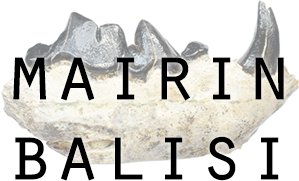Research Interests
Extinct faunas record abundant information about ecological and environmental dynamics in deep time, simultaneously enabling tests of evolutionary hypotheses generated from extant ecosystems and providing baselines for navigating current rapid global biodiversity change. From species to communities and from thousands to millions of years, I use the fossil record to understand the roots of modern biodiversity, with three main areas of inquiry: (1) diet and locomotion of extant and extinct animals; (2) ecomorphological controls on biodiversity in deep time; and (3) interactions among ecology, environment, and extinction. Carnivorous mammals are well represented as fossils, making them an excellent system for this work.
Diet and locomotion of extant and extinct animals
A Pliocene dog the size of a small wolf, Borophagus parvus, fed on prey larger than itself—suggesting that it hunted socially and that the extinction of the genus, the last of the bone-cracking dogs, could have impacted decomposition and nutrient cycling in North American ecosystems (2018, J Vert Paleo; 2018, eLife). Meanwhile, injuries in extinct predators like the saber-toothed cat Smilodon and early Canis suggest that sociality facilitated their success in predator-rich Pleistocene ecosystems (2017, Nature Ecol Evol; in revision, PLOS One; in prep).
Ecomorphological controls on biodiversity in deep time
In 40 million years of dog evolution, maximum geographic range size had no impact on species durations. However, I confirmed a previously quantified association between shorter species durations and greater carnivory and revealed a parallel pattern among species exhibiting lesser carnivory, reinforcing the idea that specialization in either direction can negatively impact subsequent diversification. Extinct canids filled niches no longer present or occupied in modern ecosystems, underscoring today’s depauperate fauna (2018, R Soc Open Sci).
Interactions among ecology, environment, and extinction
From the Oligo-Miocene to the present, large-predator extinction rates of North American fossil dogs were on par with non-predators, but subfamily-level extinction accelerated once large predators appeared. Large predators experienced elevated extinction only at the end-Pleistocene. Global temperature and continental diversification are associated only in Caninae, the lone extant canid subfamily, reinforcing an intrinsically rather than extrinsically driven decline of large predators prior to anthropogenic influence (in revision, Commun Biol).
Apart from the central themes above, my work also has branched into paleopathology. I compared patterns of traumatic injury between the saber-tooth cat and dire wolf (2017, Nature Ecology & Evolution) and partnered with orthopedic surgeons to diagnose the oldest known case of hip dysplasia in a cat (in revision, PLOS One).
Currently, my students and I use biomechanical and ecomorphological proxies on asphaltic vertebrate collections at Rancho La Brea, Los Angeles, California, to weigh the roles of ecological and environmental disturbance in shaping the diversity of small to medium-sized carnivores (mesocarnivores) from 50,000 years ago to the present. Key to this project is radiocarbon dating (to build a robust chronological framework on which to scaffold ecological inferences) and stable isotope analysis (to reconstruct diet and food webs using proxies independent of ecomorphology). Stay tuned for our results!



